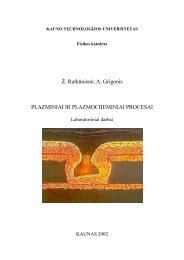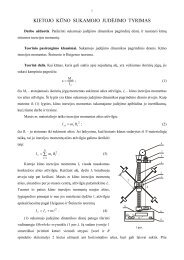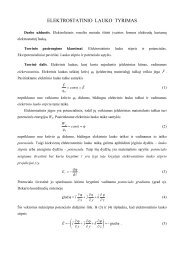PROCEEDINGS OF THE 7 INTERNATIONAL ... - Fizika
PROCEEDINGS OF THE 7 INTERNATIONAL ... - Fizika
PROCEEDINGS OF THE 7 INTERNATIONAL ... - Fizika
Create successful ePaper yourself
Turn your PDF publications into a flip-book with our unique Google optimized e-Paper software.
MEDICAL PHYSICS IN <strong>THE</strong> BALTIC STATES 7 (2009)<br />
Proceedings of International Conference “Medical Physics 2009”<br />
8 - 10 October 2009, Kaunas, Lithuania<br />
APPLICATION <strong>OF</strong> A SYN<strong>THE</strong>TIC DIAMOND DETECTOR FOR <strong>THE</strong><br />
MEASUREMENT <strong>OF</strong> RELATIVE DOSE DISTRIBUTIONS IN RADIO<strong>THE</strong>RAPY<br />
N. KAZUCHITS*, M. RUSETSKYI*, A. SHULENKOV**, V. KUKUSHKIN***,<br />
S. MARTYNOV***, V. KHRUNOV***, J. TUZOV***,<br />
G. GATSKEVICH****, D. KANDYBOVICH****<br />
* Belarussian State University, 220030 Minsk, Belarus;<br />
** UP Minskii NII Radiomaterialov 220024 Minsk, Belarus;<br />
*** Institute in Physical and Technical Problems 141980 Dubna, Moscow Region;<br />
**** N.N. Alexandrov National Cancer Centre of Belarus Minsk, Belarus<br />
Abstract: The suitability of a synthetic diamond for the measurement of relative dose distributions in selected<br />
radiotherapy applications was studied. The performance of the synthetic diamond detector was analyzed by<br />
comparison with that of natural diamond detector produced by a Physikalisch-Technische Werkstatten (Freiburg,<br />
Germany) (PTW). The synthetic diamond detector is concluded to be suitable for relative dose measurements,<br />
especially when high response and high spatial resolution are required.<br />
Keywords: Diamond, detector, sensitivity, γ-rays, dose rate<br />
1. Introduction<br />
Diamond is the attractive material for radiation<br />
detectors fabrication. The main advantage of this<br />
material is its radiation hardness. For application of<br />
diamond detectors in radiotherapy it is necessary to<br />
note two additional features – chemical inertness and<br />
“tissue equivalence”. The last feature is due to atomic<br />
number of the carbon (Z=6) is similar to the effective<br />
atomic number of the human soft tissue (Z=7,4). At<br />
present time natural diamond radiation detectors for<br />
radiotherapy are under the commercial production [1].<br />
However, such detectors are rather expensive because<br />
of only a small part of natural diamond crystals is<br />
suitable for dosimetry application.<br />
Another material for radiation detectors production is<br />
high-pressure high-temperature (HPHT) synthetic<br />
diamond [2, 3]. Both natural and HPHT synthetic<br />
diamonds have practically the same physical properties<br />
[4]. The electronic applications of the HPHT material<br />
are restricted by a high concentration of the nitrogen<br />
and inhomogeneity of the crystals. Nevertheless, the<br />
improvement of the HPHT technology enables to<br />
consider synthetic diamond detectors as a future<br />
commercial product. In general, both natural and<br />
HPHT synthetic diamonds require a complex selection<br />
for dosimetry application.<br />
The purpose of this work is to compare characteristics<br />
of HPHT synthetic diamond detector with PTW natural<br />
diamond detector. Sensitivity, temporal current<br />
76<br />
stability and current linearity with dose rate were<br />
measured in high-energy photon beam.<br />
2. Details of experiment<br />
The HPHT synthetic diamond crystals produced by<br />
“Adamas-BSU” company (Minsk, Belarus) were used<br />
in our experiments. Diamond plates 0,3 mm thickness<br />
were cut from as-grown crystals. After pre-selection by<br />
UV-photoconductivity method the detector structures<br />
were fabricated on the diamond plates. For this purpose<br />
it was performed an ion implantation of boron into both<br />
surfaces of diamond followed by high temperature<br />
(1400 ºC) annealing in vacuum. Finally, the Ti+Au<br />
contacts were deposited on both boron-doped layers.<br />
Prepared structures were tested using calibrated 137 Cs<br />
irradiation source of Federal State Unitary enterprise<br />
«Institute in Physical and Technical Problems»<br />
(Dubna, Russia). Leakage current, sensitivity, preirradiation<br />
dose, stability and linearity of current with<br />
dose rate were measured.<br />
The best samples were hermetically sealed in plastic<br />
cases for certification in Basic laboratory of<br />
metrological service of the Russian centre of science of<br />
radiology and surgical technologies (St. Petersburg).<br />
Certification was carried out while γ-rays 60 Co<br />
irradiated detectors were submerged in the water<br />
phantom.<br />
Experimental results are related to the best synthetic<br />
diamond detector.








